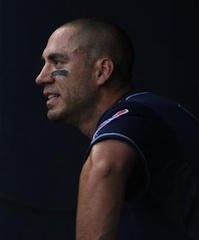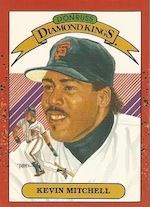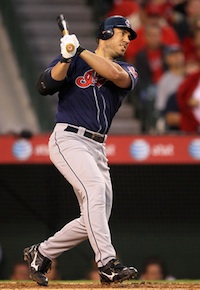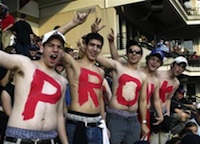 It’s the first day of June, and Travis Hafner is hurt again—exiled to the Land of Arthroscopia with the ghost of Grady Sizemore and a harsh dose of reality. For five years, even the most rational of Tribe fans have quietly—almost shamefully—kept their doors of optimism ever-so-slightly ajar; clinging to the pipe dream that a “finally healthy” Hafner could magically transform back into something approaching the Optimus Pronk of old. Aside from the occasional majestic blast off a hanging slider, however, this has never come to pass. And kids, it’s finally time to accept that it never will. Your brain, as usual, was smarter than your heart.
It’s the first day of June, and Travis Hafner is hurt again—exiled to the Land of Arthroscopia with the ghost of Grady Sizemore and a harsh dose of reality. For five years, even the most rational of Tribe fans have quietly—almost shamefully—kept their doors of optimism ever-so-slightly ajar; clinging to the pipe dream that a “finally healthy” Hafner could magically transform back into something approaching the Optimus Pronk of old. Aside from the occasional majestic blast off a hanging slider, however, this has never come to pass. And kids, it’s finally time to accept that it never will. Your brain, as usual, was smarter than your heart.
With the understanding that Hafner’s knee surgery is only technically supposed to shelve him for 4-6 weeks, this is not intended to be a career eulogy. We can save that for when his regrettable contract finally reaches its denouement in October. It does seem like as good a time as any, though, to consider Pronk’s current value—not just in terms of his legacy as an all-time Indian great, but as a piece in the complex puzzle of this 2012 ballclub.
Pronk in Perspective
Starting with the big picture, it’s mildly depressing to evaluate Travis Hafner’s eventual standing in the national baseball consciousness (when he finally does hang ‘em up), considering the grand heights he once seemed destined for. For a good chunk of the 00s decade, Travis was every bit the equal of David Ortiz—an elite, left-handed DH who hit for both average and power, racking up 100 RBIs and 100 walks every season, and just generally striking fear into the hearts of all opposing pitchers. Today, the most obvious Pronk comparison points have obviously changed drastically. As contemporaries go, there’s the ex-MVP Justin Morneau, who hasn’t played in more than 90 games since 2009. Going back a little further in time, there’s recollections of other young sluggers who caught the injury bug and flamed out—Glenn Davis, Tony Clark, Jason Bay. Maybe the best parallel tale belongs to that of the less-than-legendary Kevin Mitchell, who was a similar late bloomer that rapidly emerged as one of the game’s most dominant power hitters—only to have his legacy ultimately reduced to a kooky bare-hand catch of a flyball in left field (popularized in every “Baseball Bloopers” VHS tape of the early ‘90s). Observe the similarities:
 First, their peak seasons:
First, their peak seasons:
Kevin Mitchell (1989, age 27): 152 G, 47 HR, 125 RBI, .291 AVG, 1.023 OPS
Travis Hafner (2006, age 28): 129 G, 42 HR, 117 RBI, .308 AVG, 1.097 OPS
And now their career digits:
Mitchell: 13 years, 234 HR, 760 RBI, .284 AVG, .880 OPS
Hafner: 11 years, 195 HR, 683 RBI, .279 AVG, .891 OPS
Kinda puts things in perspective a bit, doesn’t it?
Both Mitchell and Hafner followed up their crazy monster seasons with solid campaigns in 1990 and 2007, respectively. But from that point on, neither would drive in 100 runs again, and injuries (and fatness in Mitchell’s case) would turn them into marginalized figures. Maybe your remember K-Mitch swatting a robust .153 for the Indians in 20 games back in 1997? As for Pronk, his career became the baseball equivalent of NBC's "The Office"-- highly successful and entertaining from 2005 to 2007, but increasingly unworthy of anchoring a lineup with each passing season; not unwatchable, but rarely must-see TV.
Now, you could also argue that Mitchell and Hafner’s career arcs look like textbook cases of steroid use, and both men have certainly had those accusations loosely tossed in their directions. But being in no possession of any pre-owned Pronk syringes, myself, I’ll be glossing over that whole issue entirely from this point forward.
To Haf or Haf Not
Okay, so Pronk will never be elected to anything beyond the National Hall of Adequacy. But what about in the context of Cleveland baseball history? Well, even with the dead weight of five DL-icious years in a row, Hafner has managed to etch his name all over the Indians record book. Have a gander at his ranks in some of these fairly meaningful categories.
 OBP: .384 (#17)
OBP: .384 (#17)
SLG: .510 (#10)
OPS: .894 (#11)
WAR: 22.5 (#23)
Games: 1,051 (#25, tied with Ray Chapman)
Walks: 552 (#13)
Total Bases: 1,861 (#16)
Doubles: 238 (#12)
Homeruns: 194 (#8)
RBI: 677 (#14)
He’s also second only to Jim Thome in career strikeouts, but that’s beside the point. Let’s just say that the argument could certainly be made that Travis Hafner is one of the top 20 offensive players in Indians history. If that merely registers as a “meh” to you (considering Mike Hargrove had a higher career OBP, for example), then let’s re-examine the man’s value to his own team, rather than the “franchise.”
Including a cup of coffee with Texas in 2002, Pronk has played in 1,074 games in his career. Of those, his team won 525 and lost 549. Now, just about any decent Major Leaguer will have much better career stats in his team’s victories than their losses. It’s just logic. But sometimes, the gap between the two can be at least a little bit revealing—in terms of how much a team’s success can be impacted by the efforts of its best players.
Hafner Career Stats
When His Team Wins: 525 G, 129 HR, 456 RBI, .322 AVG, 1.050 OPS
When His Team Loses: 549 G, 66 HR, 227 RBI, .237 AVG, .727 OPS
And how about this season? Useless old Pronk in 2012?
When the Indians win: 22 G, 5 HR, 15 RBI, .301 AVG, 1.035 OPS
When the Indians lose: 17 G, 1 HR, 8, RBI, .169 AVG, .536 OPS
Again, there is a two-way relationship in effect here (if the Indians are crushing a shitty Twins pitcher, Pronk probably is, too). But the relationship is there, nonetheless, be it cause-and-effect or not… "As go the Indians, so goes Pronk-- and more often than not-- vice versa," said no one in particular. Or, to paraphrase in snappy italics text: When Pronk smashes, the Indians win. When Pronk sucks, the Indians lose.
Lest it be forgotten, Hafner’s current on-base percentage of .380 STILL ranks him #14 in the American League, too. So, if you'll allow a quick tweak… When Pronk smashes-- or merely gets on base in any manner whatsoever-- the Indians win.
Pronk, Counter-Pronk
Now, for those who say “good riddance” as Haf takes his latest hiatus, there are plenty of numbers to support their case, as well.

Though he’s been a decent .256 hitter against lefties in his career, Hafner has hit an abysmal .150 (6-for-40) off them this season (still better than Choo, believe it or not). Then there’s that whole little matter of driving in runs. Pronk is a career .267 hitter with runners in scoring position. In 2012, he’s at an eye-popping .133 (6-for-45) with zero homers. Even if you don’t subscribe to the concept of “clutch” (and yes, SAC flies and RBI groundouts are fine and dandy), there’s still a point where your middle-of-the-order hitters have to pose a threat for the lineup as a whole to operate effectively.
So, who exactly is Travis Hafner in 2012? And how important is his eventual return to the Indians’ ever-cloudy playoff hopes? Is he the patient, veteran slugger that will get on base for you, hit the occasional walkoff bomb, and make opposing managers think twice about matchups late in ballgames? Or is he a broken down shell of a once great player—helpless against southpaws and painfully incapable of serving his primary role as a run producer?
Well, when it comes to the man who was famously part project AND part donkey, one simple assessment will never quite do, will it? Fact is-- no matter if you’re mourning the loss of a cleanup hitter or celebrating the opportunities for his replacements—some part of you will carry on the torch. In some microscopic sliver of your soul, you will believe that Travis Hafner will mash again. That he’ll crush one when it counts again. You will always believe.
Idiot.